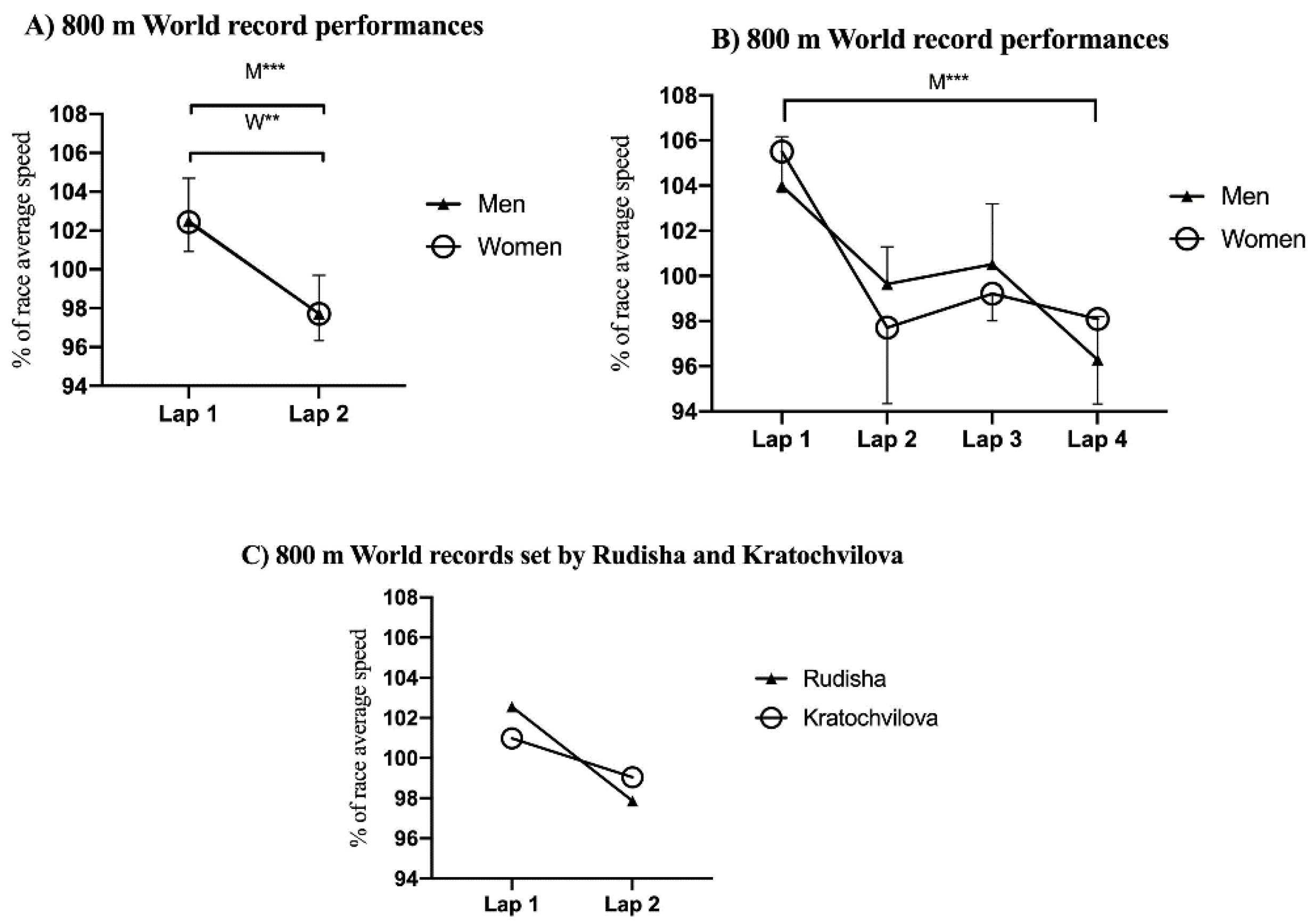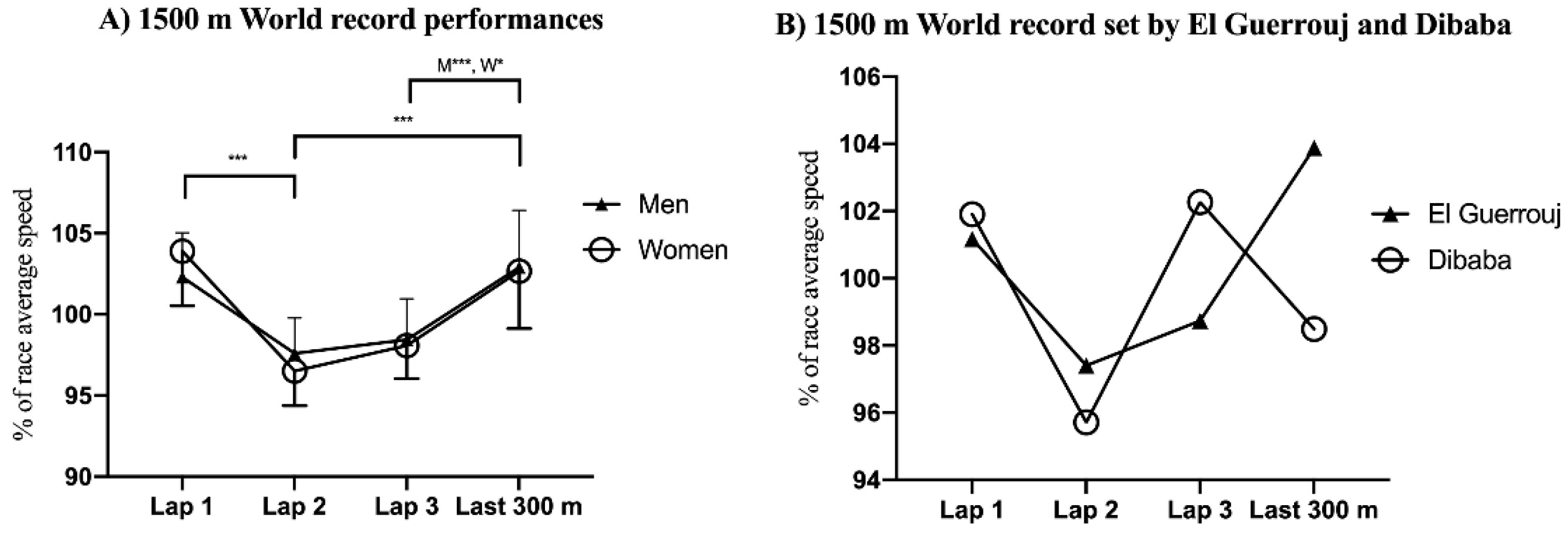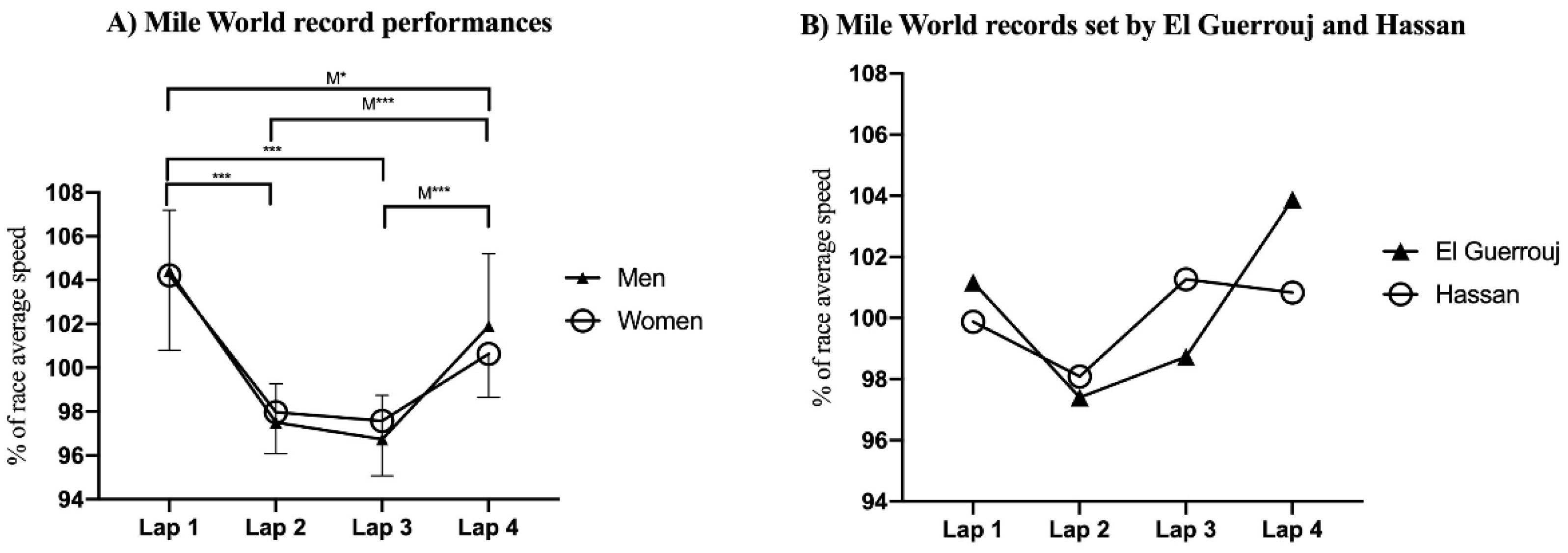Pacing Profiles of Middle-Distance Running World Records in Men and Women
Abstract
:1. Introduction
2. Materials and Methods
2.1. Pacing Data
2.2. Design and Methodology
2.3. Statistical Analysis
3. Results
4. Discussion
5. Conclusions
Practical Applications
Author Contributions
Funding
Institutional Review Board Statement
Informed Consent Statement
Data Availability Statement
Conflicts of Interest
References
- Foster, C. Vo2max and training indices as determinants of competitive running performance. J. Sports Sci. 1983, 1, 13–22. [Google Scholar] [CrossRef]
- Gibson, A.S.C.; de Koning, J.J.; Thompson, K.G.; Roberts, W.O.; Micklewright, D.; Raglin, J.; Foster, C. Crawling to the Finish Line: Why do Endurance Runners Collapse?: Implications for Understanding of Mechanisms Underlying Pacing and Fatigue. Sports Med. 2013, 43. [Google Scholar] [CrossRef]
- Casado, A.; Moreno-Pérez, D.; Larrosa, M.; Renfree, A. Different psychophysiological responses to a high-intensity repetition session performed alone or in a group by elite middle-distance runners. Eur. J. Sport. Sci. 2019, 19, 1045–1052. [Google Scholar] [CrossRef]
- Renfree, A.; Casado, A.; Pellejero, G.; Hanley, B. More pace variation and pack formation in successful world-class 10,000-m runners than in less successful competitors. Int. J. Sports Physiol. Perform. 2020, 15, 1369–1376. [Google Scholar] [CrossRef]
- Pugh, L.G.C.E. The influence of wind resistance in running and walking and the mechanical efficiency of work against horizontal or vertical forces. J. Physiol. 1971, 213, 255–276. [Google Scholar] [CrossRef] [PubMed]
- Renfree, A.; Casado, A. Athletic races represent complex systems, and pacing behavior should be viewed as an emergent phenomenon. Front. Physiol. 2018. [Google Scholar] [CrossRef] [PubMed] [Green Version]
- Foster, C.; De Koning, J.J.; Thiel, C. Evolutionary pattern of improved 1-mile running performance. Int. J. Sports Physiol. Perform. 2014, 9, 715–719. [Google Scholar] [CrossRef]
- Casado, A.; Hanley, B.; Jiménez-Reyes, P.; Renfree, A. Pacing profiles and tactical behaviors of elite runners. J. Sport Heal. Sci. 2020. [Google Scholar] [CrossRef]
- Díaz, J.J.; Fernández-Ozcorta, E.J.; Santos-Concejero, J. The influence of pacing strategy on marathon world records. Eur. J. Sport. Sci. 2018, 18, 781–786. [Google Scholar] [CrossRef]
- Foster, C.; de Koning, J.J.; Thiel, C.; Versteeg, B.; Boullosa, D.A.; Bok, D.; Porcari, J.P. Beating Yourself: How Do Runners Improve Their Own Records? Int. J. Sports. Physiol. Perform. 2019, 15, 437–440. [Google Scholar] [CrossRef] [PubMed]
- Tucker, R.; Lambert, M.I.; Noakes, T.D. An analysis of pacing strategies during men’s world-record performances in track athletics. Int. J. Sports Physiol. Perform. 2006, 1, 233–245. [Google Scholar] [CrossRef] [PubMed] [Green Version]
- Casado, A.; García-Manso, J.M.; Romero-Franco, N.; Martínez-Patiño, M.J. Pacing strategies during male 1500 m running world record performances. Res. Sports Med. 2021. [Google Scholar] [CrossRef]
- Noakes, T.D.; Lambert, M.I.; Hauman, R. Which lap is the slowest? An analysis of 32 world mile record performances. Br. J. Sports Med. 2009, 43, 760–764. [Google Scholar] [CrossRef]
- Sandford, G.N.; Pearson, S.; Allen, S.V.; Malcata, R.M.; Kilding, A.E.; Ross, A.; Laursen, P.B. Tactical behaviors in men’s 800-m olympic and world-championship medalists: A changing of the guard. Int. J. Sports Physiol. Perform. 2018, 13, 246–249. [Google Scholar] [CrossRef] [PubMed]
- Díaz, J.J.; Fernández-Ozcorta, E.J.; Torres, M.; Santos-Concejero, J. Men vs. women world marathon records’ pacing strategies from 1998 to 2018. Eur. J. Sports Sci. 2019, 19, 1297–1302. [Google Scholar] [CrossRef]
- Renfree, A.; Martin, L.; Micklewright, D.; St Clair Gibson, A. Application of decision-making theory to the regulation of muscular work rate during self-paced competitive endurance activity. Sports Med. 2014, 44, 147–158. [Google Scholar] [CrossRef] [PubMed]
- Hymans, R.; Matrahazi, I. (Eds.) Progression of IAAF World Records; IAAF Atletics: Monte Carlo, Monaco, 2015. [Google Scholar]
- Cohen, J. Statistical Power Analysis for the Behavioural Sciences, 2nd ed.; Lawrence Earlbaum Associates: Hillsdale, NJ, USA, 1988. [Google Scholar]
- Cohen, J. Statistical Power Analysis. Curr. Dir. Psychol. Sci. 1992, 1, 98–101. [Google Scholar] [CrossRef]
- Hanley, B.; Stellingwerff, T.; Hettinga, F.J. Successful pacing profiles of olympic and IAAF World Championship middle-distance runners across qualifying rounds and finals. Int. J. Sports Physiol. Perform. 2019, 14, 894–901. [Google Scholar] [CrossRef] [Green Version]
- Casado, A.; Renfree, A.; Jaenes-Sánchez, J.C.; Cuadrado-Peñafiel, V.; Jiménez-Reyes, P. Differentiating endurance-and speed-adapted types of elite and world class milers according to biomechanical, pacing and perceptual responses during a sprint interval session. Int. J. Environ. Res. Public Health 2021, 18, 2448. [Google Scholar] [CrossRef] [PubMed]
- Filipas, L.; Ballati, E.N.; Bonato, M.; La Torre, A.; Piacentini, M.F. Elite male and female 800-m runners⇔ display of different pacing strategies during season-best performances. Int. J. Sports Physiol. Perform. 2018, 13, 1344–1348. [Google Scholar] [CrossRef] [PubMed]
- Fukuba, Y.; Whipp, B.J. A metabolic limit on the ability to make up for lost time in endurance events. J. Appl. Physiol. 1999, 87, 853–861. [Google Scholar] [CrossRef]
- Thiel, C.; Foster, C.; Banzer, W.; de Koning, J. Pacing in Olympic track races: Competitive tactics versus best performance strategy. J. Sports Sci. 2012, 30, 1107–1115. [Google Scholar] [CrossRef] [PubMed] [Green Version]
- Casado, A.; Renfree, A. Fortune Favors the Brave. Tactical Behaviors in the Middle Distance Running Events at the 2017 IAAF World Championships. Int. J. Sports Physiol. Perform. 2018, 13, 1–22. [Google Scholar] [CrossRef] [PubMed]
- Deaner, R.O.; Addona, V.; Carter, R.E.; Joyner, M.J.; Hunter, S.K. Fast men slow more than fast women in a 10 kilometer road race. PeerJ 2016, 4, e2235. [Google Scholar] [CrossRef] [PubMed] [Green Version]
- Deaner, R.O.; Lowen, A. Males and Females Pace Differently in High School Cross-Country Races. J. Strength Cond. Res. 2016, 30, 2991–2997. [Google Scholar] [CrossRef] [PubMed]
- Deaner, R.O.; Carter, R.E.; Joyner, M.J.; Hunter, S.K. Men are more likely than women to slow in the marathon. Med. Sci. Sports Exerc. 2014, 47, 607–616. [Google Scholar] [CrossRef] [Green Version]
- March, D.S.; Vanderburgh, P.M.; Titlebaum, P.J.; Hoops, M.L. Age, sex, and finish time as determinants of pacing in the marathon. J. Strength Cond. Res. 2011, 25, 386–391. [Google Scholar] [CrossRef] [Green Version]
- Hunter, S.K. Sex differences in human fatigability: Mechanisms and insight to physiological responses. Acta Physiol. 2014, 210, 768–789. [Google Scholar] [CrossRef] [Green Version]



| Repeated Measures ANOVA | |||||||||
|---|---|---|---|---|---|---|---|---|---|
| Between Laps | Lap and Sex Interaction | ||||||||
| Event | Number of Laps | df Residual | p | F | df | ES | p | F | ES |
| 800 m | 2 | 19 | <0.001 | 31.55 | 1 | 0.623 | 0.978 | 0.00 | 0.000 |
| 4 | 21 | <0.001 | 10.029 | 3 | 0.561 | 0.483 | 0.483 | 0.047 | |
| 1500 m | 4 | 138 | <0.001 | 31.40 | 3 | 0.397 | 0.358 | 1.08 | 0.014 |
| Mile | 4 | 95.80 | <0.001 | 39.54 | 2.39 | 0.492 | 0.486 | 0.771 | 0.010 |
Publisher’s Note: MDPI stays neutral with regard to jurisdictional claims in published maps and institutional affiliations. |
© 2021 by the authors. Licensee MDPI, Basel, Switzerland. This article is an open access article distributed under the terms and conditions of the Creative Commons Attribution (CC BY) license (https://creativecommons.org/licenses/by/4.0/).
Share and Cite
Casado, A.; González-Mohíno, F.; González-Ravé, J.M.; Boullosa, D. Pacing Profiles of Middle-Distance Running World Records in Men and Women. Int. J. Environ. Res. Public Health 2021, 18, 12589. https://doi.org/10.3390/ijerph182312589
Casado A, González-Mohíno F, González-Ravé JM, Boullosa D. Pacing Profiles of Middle-Distance Running World Records in Men and Women. International Journal of Environmental Research and Public Health. 2021; 18(23):12589. https://doi.org/10.3390/ijerph182312589
Chicago/Turabian StyleCasado, Arturo, Fernando González-Mohíno, José María González-Ravé, and Daniel Boullosa. 2021. "Pacing Profiles of Middle-Distance Running World Records in Men and Women" International Journal of Environmental Research and Public Health 18, no. 23: 12589. https://doi.org/10.3390/ijerph182312589
APA StyleCasado, A., González-Mohíno, F., González-Ravé, J. M., & Boullosa, D. (2021). Pacing Profiles of Middle-Distance Running World Records in Men and Women. International Journal of Environmental Research and Public Health, 18(23), 12589. https://doi.org/10.3390/ijerph182312589









